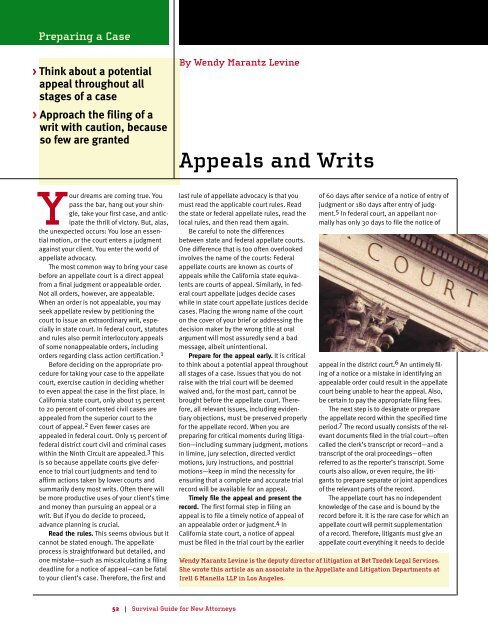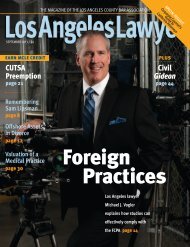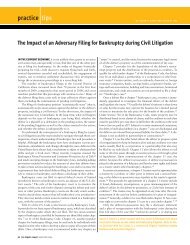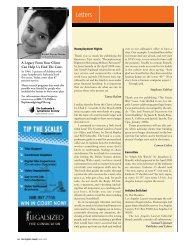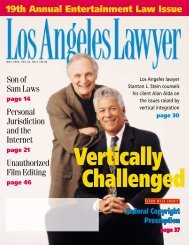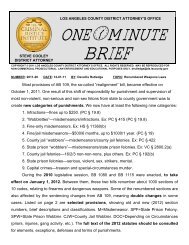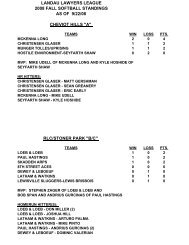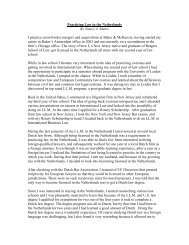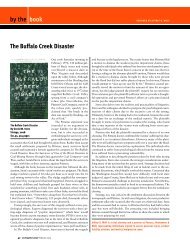Appeals and Writs - Los Angeles County Bar Association
Appeals and Writs - Los Angeles County Bar Association
Appeals and Writs - Los Angeles County Bar Association
Create successful ePaper yourself
Turn your PDF publications into a flip-book with our unique Google optimized e-Paper software.
Preparing a Case<br />
> Think about a potential<br />
appeal throughout all<br />
stages of a case<br />
> Approach the filing of a<br />
writ with caution, because<br />
so few are granted<br />
By Wendy Marantz Levine<br />
<strong>Appeals</strong> <strong>and</strong> <strong>Writs</strong><br />
Your dreams are coming true. You<br />
pass the bar, hang out your shingle,<br />
take your first case, <strong>and</strong> anticipate<br />
the thrill of victory. But, alas,<br />
the unexpected occurs: You lose an essential<br />
motion, or the court enters a judgment<br />
against your client. You enter the world of<br />
appellate advocacy.<br />
The most common way to bring your case<br />
before an appellate court is a direct appeal<br />
from a final judgment or appealable order.<br />
Not all orders, however, are appealable.<br />
When an order is not appealable, you may<br />
seek appellate review by petitioning the<br />
court to issue an extraordinary writ, especially<br />
in state court. In federal court, statutes<br />
<strong>and</strong> rules also permit interlocutory appeals<br />
of some nonappealable orders, including<br />
orders regarding class action certification. 1<br />
Before deciding on the appropriate procedure<br />
for taking your case to the appellate<br />
court, exercise caution in deciding whether<br />
to even appeal the case in the first place. In<br />
California state court, only about 15 percent<br />
to 20 percent of contested civil cases are<br />
appealed from the superior court to the<br />
courtofappeal. 2 Even fewer cases are<br />
appealed in federal court. Only 15 percent of<br />
federal district court civil <strong>and</strong> criminal cases<br />
within the Ninth Circuit are appealed. 3 This<br />
is so because appellate courts give deference<br />
to trial court judgments <strong>and</strong> tend to<br />
affirm actions taken by lower courts <strong>and</strong><br />
summarily deny most writs. Often there will<br />
be more productive uses of your client’s time<br />
<strong>and</strong> money than pursuing an appeal or a<br />
writ. But if you do decide to proceed,<br />
advance planning is crucial.<br />
Read the rules. This seems obvious but it<br />
cannot be stated enough. The appellate<br />
process is straightforward but detailed, <strong>and</strong><br />
one mistake—such as miscalculating a filing<br />
deadline for a notice of appeal—can be fatal<br />
to your client’s case. Therefore, the first <strong>and</strong><br />
last rule of appellate advocacy is that you<br />
must read the applicable court rules. Read<br />
the state or federal appellate rules, read the<br />
local rules, <strong>and</strong> then read them again.<br />
Be careful to note the differences<br />
between state <strong>and</strong> federal appellate courts.<br />
One difference that is too often overlooked<br />
involves the name of the courts: Federal<br />
appellate courts are known as courts of<br />
appeals while the California state equivalents<br />
are courts of appeal. Similarly, in federal<br />
court appellate judges decide cases<br />
while in state court appellate justices decide<br />
cases. Placing the wrong name of the court<br />
on the cover of your brief or addressing the<br />
decision maker by the wrong title at oral<br />
argument will most assuredly send a bad<br />
message, albeit unintentional.<br />
Prepare for the appeal early. It is critical<br />
to think about a potential appeal throughout<br />
all stages of a case. Issues that you do not<br />
raise with the trial court will be deemed<br />
waived <strong>and</strong>, for the most part, cannot be<br />
brought before the appellate court. Therefore,<br />
all relevant issues, including evidentiary<br />
objections, must be preserved properly<br />
for the appellate record. When you are<br />
preparing for critical moments during litigation—including<br />
summary judgment, motions<br />
in limine, jury selection, directed verdict<br />
motions, jury instructions, <strong>and</strong> posttrial<br />
motions—keep in mind the necessity for<br />
ensuring that a complete <strong>and</strong> accurate trial<br />
record will be available for an appeal.<br />
Timely file the appeal <strong>and</strong> present the<br />
record. The first formal step in filing an<br />
appeal is to file a timely notice of appeal of<br />
an appealable order or judgment. 4 In<br />
California state court, a notice of appeal<br />
must be filed in the trial court by the earlier<br />
of 60 days after service of a notice of entry of<br />
judgment or 180 days after entry of judgment.<br />
5 In federal court, an appellant normally<br />
has only 30 days to file the notice of<br />
appeal in the district court. 6 An untimely filing<br />
of a notice or a mistake in identifying an<br />
appealable order could result in the appellate<br />
court being unable to hear the appeal. Also,<br />
be certain to pay the appropriate filing fees.<br />
The next step is to designate or prepare<br />
the appellate record within the specified time<br />
period. 7 The record usually consists of the relevant<br />
documents filed in the trial court—often<br />
called the clerk’s transcript or record—<strong>and</strong> a<br />
transcript of the oral proceedings—often<br />
referred to as the reporter’s transcript. Some<br />
courts also allow, or even require, the litigants<br />
to prepare separate or joint appendices<br />
of the relevant parts of the record.<br />
The appellate court has no independent<br />
knowledge of the case <strong>and</strong> is bound by the<br />
record before it. It is the rare case for which an<br />
appellate court will permit supplementation<br />
of a record. Therefore, litigants must give an<br />
appellate court everything it needs to decide<br />
Wendy Marantz Levine is the deputy director of litigation at Bet Tzedek Legal Services.<br />
She wrote this article as an associate in the Appellate <strong>and</strong> Litigation Departments at<br />
Irell & Manella LLP in <strong>Los</strong> <strong>Angeles</strong>.<br />
52 ❘ Survival Guide for New Attorneys
the case <strong>and</strong> not bury any pertinent information<br />
in irrelevant or duplicative filings.<br />
Carefully prepare the requisite appellate<br />
briefs. When the record is complete, the parties<br />
prepare written briefs, which are the<br />
heart of the appellate process. 8 The typical<br />
appeal consists of three briefs: the appellant’s<br />
opening brief, the respondent’s brief,<br />
<strong>and</strong> the appellant’s reply brief.<br />
Because page limits are strict <strong>and</strong> the<br />
stakes are high, take time to organize your<br />
briefs <strong>and</strong> to perfect the writing so that you<br />
capture <strong>and</strong> rivet the court’s attention.<br />
Seemingly small sections of briefs—such as<br />
the summary of argument, the introduction,<br />
or the presentation of issues—may be the<br />
critical portions that judges will reference<br />
before hearing oral argument or when rendering<br />
an opinion. Treat every word in a brief<br />
as an opportunity to convince the court of<br />
your client’s position.<br />
In order to carefully select the issues that<br />
you want to present <strong>and</strong> the way that you<br />
want to present them, you must be cognizant<br />
of the st<strong>and</strong>ard of review that governs<br />
the issues. The structure of a brief will be<br />
different depending on whether the appellate<br />
court is reviewing questions of law,<br />
questions of fact, discretionary rulings, or<br />
mixed questions of law <strong>and</strong> fact.<br />
If a judgment involving an evidentiary<br />
conflict is supported by substantial evidence,<br />
the appellate court will not decide<br />
the facts. Moreover, a discretionary ruling of<br />
the trial judge will not be disturbed absent a<br />
clear showing of an abuse of discretion. If<br />
the appellate court determines that the trial<br />
court made an error but the error is harmless,<br />
the appellate court will not overturn the<br />
judgment unless the error will result in a<br />
miscarriage of justice.<br />
Practice your oral argument. Litigants<br />
appealing an order or judgment in California<br />
state court have a right to an oral argument<br />
after the briefing is complete. 9 There is no<br />
corollary right to oral argument in federal<br />
court, although federal courts do hear oral<br />
argument in cases in which the courts think<br />
that oral argument will be helpful. 10 Your<br />
brief is your only opportunity to convince<br />
federal appellate judges that oral argument<br />
is warranted.<br />
During oral argument, you will have only<br />
10 to 30 minutes to convince the appellate<br />
panel that the position in your briefs is correct<br />
<strong>and</strong> to clarify any points that may be<br />
unclear. Oral argument is not an opportunity<br />
to summarize your briefs or to raise new<br />
issues. The best oral arguments are those in<br />
which the litigants answer the court’s questions<br />
<strong>and</strong> sit down when their points are<br />
made, even if they have time left to spare.<br />
The privilege of appearing before an<br />
appellate court carries with it the responsibility<br />
to be intimately familiar with the record<br />
<strong>and</strong> the strengths <strong>and</strong> weaknesses of your<br />
case. To prepare properly, you should practice<br />
your oral argument with your colleagues<br />
<strong>and</strong> your client. Videotaping moot sessions<br />
<strong>and</strong> critiquing them will yield benefits that<br />
will be apparent during the actual argument.<br />
Consider filing a writ. When an appeal is<br />
not available because the contested order is<br />
not appealable, a writ may provide relief. A<br />
writ is a judicial order, often from a higher<br />
court to a lower court, to perform or refrain<br />
from performing a specified act. Appellate<br />
courts have discretion to review nonappealable<br />
orders <strong>and</strong> judgments through writ<br />
applications (also called petitions).<br />
Approach the filing of a writ with caution,<br />
since 90 percent of writ applications filed in<br />
California courts are denied. 11 As infrequently<br />
as writs are granted in the state system,<br />
they are even rarer in the federal system.<br />
12 The Ninth Circuit frowns upon writs.<br />
Indeed, it will only grant them in extraordinary<br />
cases, including those in which 1) there<br />
is no avenue of direct appeal, 2) the petitioner<br />
will be harmed in a way not correctable<br />
on appeal, 3) the district court has<br />
taken a clearly erroneous action warranting<br />
immediate relief, or 4) the district court’s<br />
error is an oft-repeated one or presents a<br />
new <strong>and</strong> important issue. 13<br />
The California Court of Appeal has original<br />
jurisdiction over three general types of<br />
statutory writs:<br />
• <strong>Writs</strong> of m<strong>and</strong>ate to correct an abuse of<br />
discretion or to compel performance of a<br />
ministerial duty. 14<br />
• <strong>Writs</strong> of prohibition to prevent a threatened<br />
judicial act in excess of jurisdiction. 15<br />
• <strong>Writs</strong> of certiorari to correct a completed<br />
judicial act in excess of jurisdiction. 16<br />
While the California Legislature has<br />
authorized these writs, appellate courts still<br />
have discretion to decide if they will grant or<br />
deny a writ.<br />
Filing a petition for a writ is a far different<br />
process than filing a complaint or an appeal.<br />
The client or the attorney must verify the writ<br />
petition on the basis of personal knowledge,<br />
not information <strong>and</strong> belief. The petition must<br />
be accompanied by a memor<strong>and</strong>um of<br />
points <strong>and</strong> authorities <strong>and</strong> by all exhibits<br />
necessary for the appellate court to make a<br />
decision on the merits. While a designated<br />
record is required for an appeal, it is not<br />
required for a writ. The prevailing party in the<br />
lower court can file an unsolicited preliminary<br />
opposition or can wait to file an opposition<br />
in response to a court request. The<br />
appellate court decides whether it will hear<br />
oral argument. At the court’s discretion, it<br />
can summarily deny the petition or rule on<br />
the petition by issuing a written opinion.<br />
Consider retaining an appellate specialist.<br />
A keen trial lawyer often considers<br />
retaining an appellate specialist during trial<br />
to ensure that a case will have all the appropriate<br />
elements in place for a successful<br />
appeal if one is necessary. The appellate<br />
specialist also may be retained to h<strong>and</strong>le a<br />
writ or an appeal. The State <strong>Bar</strong> of California<br />
certifies appellate specialists. 17<br />
Although trial lawyers must be intimately<br />
familiar with their cases, having a fresh set of<br />
eyes that can see a case through the prism of<br />
experience with the appellate process <strong>and</strong><br />
with knowledge of how appellate judges<br />
approach the issues can be extremely helpful.<br />
This is particularly true when the trial<br />
lawyer’s perspective is colored by a stinging<br />
loss in the trial court.<br />
As one California court noted: “Appellate<br />
work is most assuredly not the recycling of<br />
trial level points <strong>and</strong> authorities….Rather<br />
than being a rehash of trial level points <strong>and</strong><br />
authorities, the appellate brief offers counsel<br />
probably their best opportunity to craft<br />
work of original, professional, <strong>and</strong>, on occasion,<br />
literary value.” 18 ■<br />
1 FED. R. CIV. P. 23(f), 54(b); 28 U.S.C. §1292(b).<br />
2 JON B. EISENBERG, ELLIS J. HORVITZ & JUSTICE HOWARD B.<br />
WIENER, CALIFORNIA PRACTICE GUIDE: CIVIL APPEALS AND WRITS<br />
§1:38 (2004) [hereinafter EISENBERG].<br />
3 JUDGE DOROTHY W. NELSON, CHRISTOPHER A. GOELZ & MEREDITH<br />
J. WATTS, FEDERAL NINTH CIRCUIT CIVIL APPELLATE PRACTICE §1:50<br />
(2004) [hereinafter NELSON].<br />
4 FED. R. APP. P. 3; CAL. R. OF CT.1.<br />
5 CAL. R. OF CT. 2(a).<br />
6 FED. R. APP. P. 4(a)(1)(A).<br />
7 FED. R. APP. P. 10-12; CAL. R. OF CT. 4–12.5.<br />
8 FED. R. APP. P. 28; CAL. R. OF CT. 13–17.<br />
9 CAL. CONST. art. VI, §3.<br />
10 FED. R. APP. P. 34(a)(2).<br />
11 Eisenberg, supra note 2, at §15:1.3.<br />
12 Nelson, supra note 3, at §13:11; see also 28 U.S.C.<br />
§1651; FED. R. APP. P. 21.<br />
13 Bauman v. United States Dist. Court, 557 F. 2d 650,<br />
654–55 (9th Cir. 1977) (establishing test for evaluating<br />
writs).<br />
14 CODE CIV. PROC. §1085.<br />
15 CODE CIV. PROC. §1102.<br />
16 CODE CIV. PROC. §1068.<br />
17 For information on the State <strong>Bar</strong>’s requirements for certification<br />
as an appellate law specialist, see http://www<br />
.calbar.ca.gov.<br />
18 Marriage of Shaban, 88 Cal. App. 4th 398, 408–10<br />
(2001).<br />
Survival Guide for New Attorneys ❘ 53


